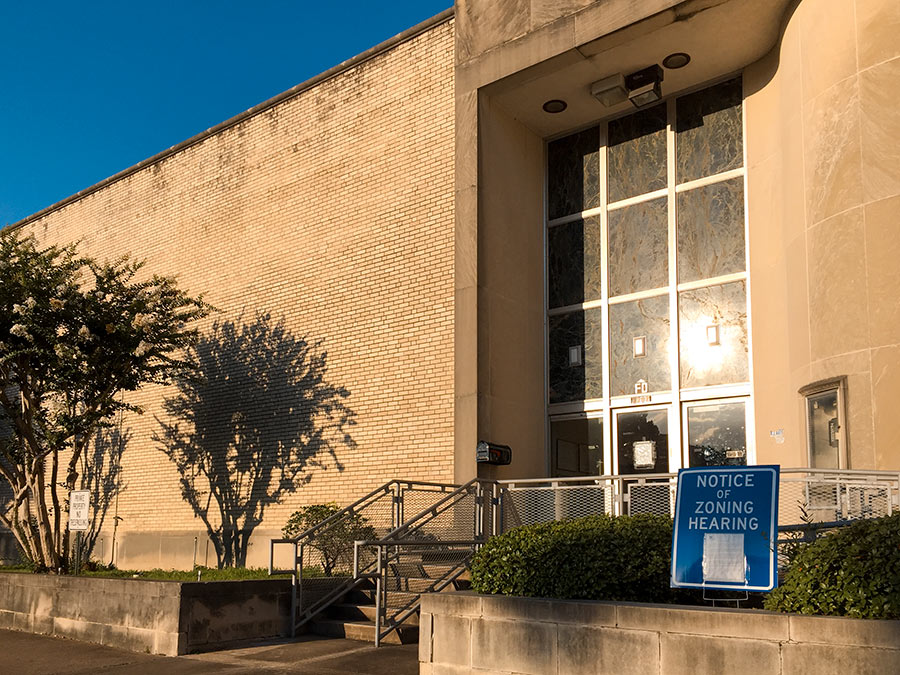
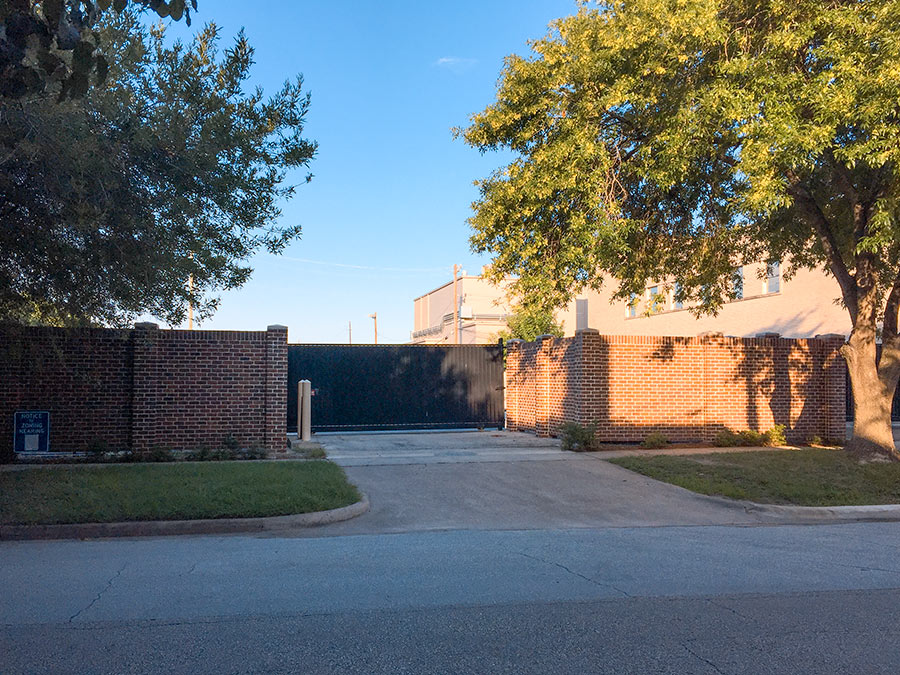
Signs are up outside AT&T’s West U. building on Bellaire Blvd. announcing the changes the carrier wants to make to allow service vehicles to load and unload gear in its backyard. Laid down on a row of 4 former residential lots in 1970, the parking lot was expanded by 2 parcels in 1975 and now backs both the telecom building and the Whole Foods–anchored shopping center adjacent to it. Service vehicles and their associated personnel have used the lot since it was first paved, according to the company’s rezoning application.
West U. officials signed off on the land’s new use for parking back when it was first paved. The question now is what is what sort of backyard activities are permitted within that area — an issue on which the city has flip-flopped. In 2016, it gave AT&T the all-clear to keep conducting service activities in the lot. But following a challenge from a neighboring resident that same year, officials changed their minds. AT&T filed a lawsuit in response, but just this January agreed to work toward a settlement with the city.
A public hearing on the zoning request was originally scheduled for June 11 but was postponed to a date TBD — prompting some timely yard sign edits like the one shown below


 “. . . I must LOL whenever I see one of these articles blaming our flooding on our lack of zoning, and as an example of our lack of zoning, the article will show some subdivision in Sugar Land or Katy. Last time I checked, neither of those places are inside the city limits of Houston. Also, don’t those subdivisions have zoning up the ying yang? . . .” [
“. . . I must LOL whenever I see one of these articles blaming our flooding on our lack of zoning, and as an example of our lack of zoning, the article will show some subdivision in Sugar Land or Katy. Last time I checked, neither of those places are inside the city limits of Houston. Also, don’t those subdivisions have zoning up the ying yang? . . .” [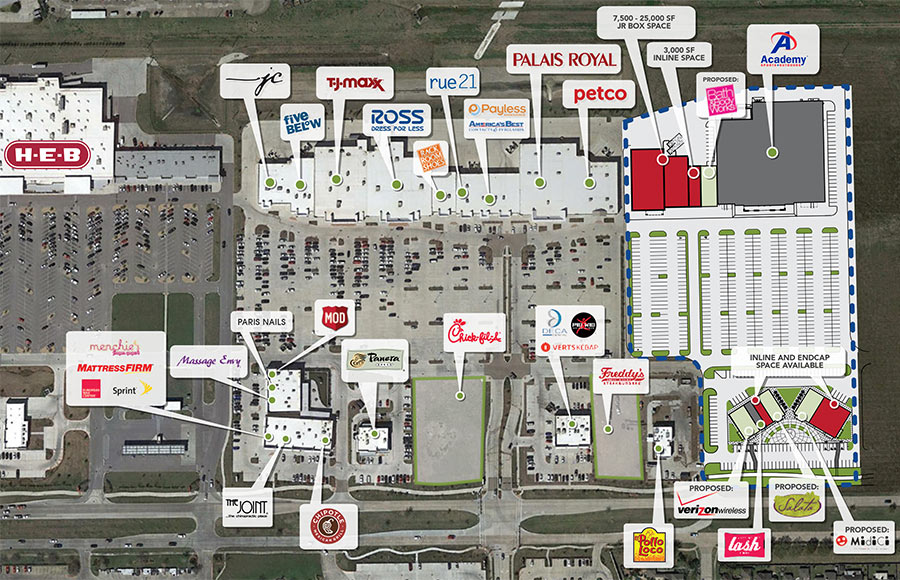
 “Blame our city’s efforts at ‘planning’ in lieu of zoning. In the early 70’s, due to insufficient wastewater infrastructure, the city enacted a ban on apartment buildings of more than 4 units inside the Loop (driving much of apartment development to Uptown and Meyerland) and enforced a 5000-sq.-ft. minimum lot size. This gave rise to the Montrose 4-plex (of which there are
“Blame our city’s efforts at ‘planning’ in lieu of zoning. In the early 70’s, due to insufficient wastewater infrastructure, the city enacted a ban on apartment buildings of more than 4 units inside the Loop (driving much of apartment development to Uptown and Meyerland) and enforced a 5000-sq.-ft. minimum lot size. This gave rise to the Montrose 4-plex (of which there are 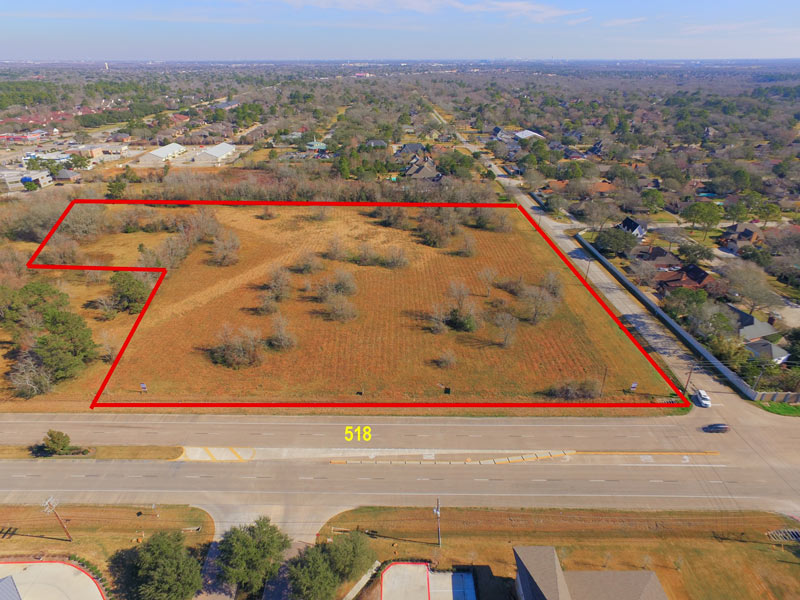
 “Another example of the city’s zoning-style regulations that have been built up over the last 20 years or so. They couldn’t get people to vote for zoning, so they are building a zoning apparatus slowly and in small pieces.” [
“Another example of the city’s zoning-style regulations that have been built up over the last 20 years or so. They couldn’t get people to vote for zoning, so they are building a zoning apparatus slowly and in small pieces.” [ “. . . Nobody can deny that Houston does things differently, but it does these things in part by not doing something that every other major city does — by bucking the trend despite repeated opportunities to go along with that trend. Houston is so notable in this regard that the
“. . . Nobody can deny that Houston does things differently, but it does these things in part by not doing something that every other major city does — by bucking the trend despite repeated opportunities to go along with that trend. Houston is so notable in this regard that the  “. . . I always chuckle a bit when someone thinks that the free market governs Houston because the City doesn’t have zoning.
Aside from land-use restrictions, every regulation that is usually found in a zoning ordinance is in force in Houston. Tree and landscape requirements. Setbacks. Sign ordinance. Curb cut requirements. Buffering. Parking requirements. Traffic study requirements. Plan reviews for subdivisions. Regulations for building in flood plains and finish floor elevations. The list goes on. And like every other city, Houston enforces building, electrical, fire, residential, and plumbing codes (with amendments). So contrary to what a lot of a lot of people think, Houston is not a developer’s free for all. (Not that it wasn’t in the 1970s, but I digress)
If anything, it’s harder to build in Houston because the regulations are so damned hard to find sometimes. In most places, it’s all neatly packaged in a Zoning Ordinance. In Houston, it’s all over the Code of Ordinances, and you have to know where to look. As
“. . . I always chuckle a bit when someone thinks that the free market governs Houston because the City doesn’t have zoning.
Aside from land-use restrictions, every regulation that is usually found in a zoning ordinance is in force in Houston. Tree and landscape requirements. Setbacks. Sign ordinance. Curb cut requirements. Buffering. Parking requirements. Traffic study requirements. Plan reviews for subdivisions. Regulations for building in flood plains and finish floor elevations. The list goes on. And like every other city, Houston enforces building, electrical, fire, residential, and plumbing codes (with amendments). So contrary to what a lot of a lot of people think, Houston is not a developer’s free for all. (Not that it wasn’t in the 1970s, but I digress)
If anything, it’s harder to build in Houston because the regulations are so damned hard to find sometimes. In most places, it’s all neatly packaged in a Zoning Ordinance. In Houston, it’s all over the Code of Ordinances, and you have to know where to look. As 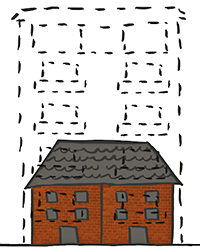 “For a city without zoning, development in Houston isn’t much different that it would be if we DID have zoning. Most retail development happens on major commercial thoroughfares, and most industrial sites are either along railway lines or otherwise clustered together. And development still has to comply with our (idiotic) setback requirements and parking minimums.
The main difference Houston has over other cities with stricter land use regulation, is the ability to increase residential density in a fairly timely manner. This has helped keep housing costs from rising higher than they otherwise would have. The kinds of land use regulation in cities like New York, Washington and San Francisco generally benefit wealthy landowners at the expense of younger, poorer new-comers. Even current middle-class homeowners don’t really benefit: you can’t bank the appreciation until you sell, at which point you still have to live somewhere, and in the meantime, your property tax bill is higher.” [
“For a city without zoning, development in Houston isn’t much different that it would be if we DID have zoning. Most retail development happens on major commercial thoroughfares, and most industrial sites are either along railway lines or otherwise clustered together. And development still has to comply with our (idiotic) setback requirements and parking minimums.
The main difference Houston has over other cities with stricter land use regulation, is the ability to increase residential density in a fairly timely manner. This has helped keep housing costs from rising higher than they otherwise would have. The kinds of land use regulation in cities like New York, Washington and San Francisco generally benefit wealthy landowners at the expense of younger, poorer new-comers. Even current middle-class homeowners don’t really benefit: you can’t bank the appreciation until you sell, at which point you still have to live somewhere, and in the meantime, your property tax bill is higher.” [ Glasstire’s Bill Davenport has a suggestion: “Its famous lack of zoning is one of the few things Houston offers artists that other cities can’t. It’s been a defining feature of the city, and one of its main attractions for artists for decades. But this isn’t happening anymore. Prosperity has put teeth into Houston code enforcement, whose numerous inspectors now patrol the streets, ready to red-tag any unconventional building activity.
It’s vital that we preserve a loophole for artistic expression on an architectural scale. What once was an opportunity created naturally by low property prices and underfunded city government must now be maintained purposefully if Houston’s unique character as a city of artistic entrepreneurship is to continue. As part of the new cultural plan,
Glasstire’s Bill Davenport has a suggestion: “Its famous lack of zoning is one of the few things Houston offers artists that other cities can’t. It’s been a defining feature of the city, and one of its main attractions for artists for decades. But this isn’t happening anymore. Prosperity has put teeth into Houston code enforcement, whose numerous inspectors now patrol the streets, ready to red-tag any unconventional building activity.
It’s vital that we preserve a loophole for artistic expression on an architectural scale. What once was an opportunity created naturally by low property prices and underfunded city government must now be maintained purposefully if Houston’s unique character as a city of artistic entrepreneurship is to continue. As part of the new cultural plan, 
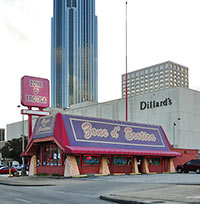 “I’ve always thought the Zone D’Erotica placement was one of the most charming things about Houston.
Welcome to Houston: you own it, you use it, however you want. Other cities would be finding a way to declare the parcel blighted at Simon’s behest, but in Houston that would be rightly considered outrageous.” [
“I’ve always thought the Zone D’Erotica placement was one of the most charming things about Houston.
Welcome to Houston: you own it, you use it, however you want. Other cities would be finding a way to declare the parcel blighted at Simon’s behest, but in Houston that would be rightly considered outrageous.” [